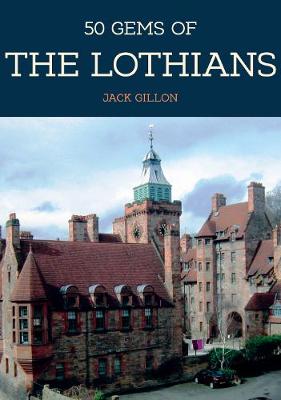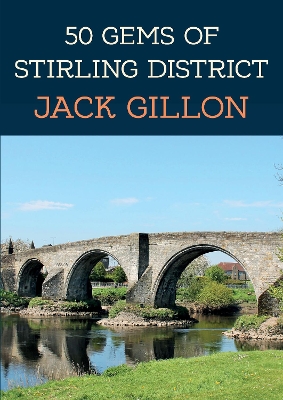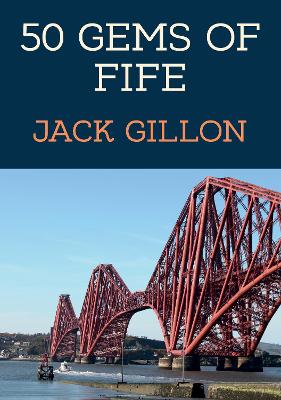50 Gems
3 total works
The historic county of Lothian lies along the south side of the broad estuary of the Forth. Its strategic location and political and economic importance, with Edinburgh at its centre, has made the county witness to some of the most significant events in Scottish history. This is reflected in the remarkable wealth of architectural heritage spanning thousands of years. Castles, royal palaces, churches and industrial buildings of national importance abound in the county.
Author Jack Gillon seeks out some of the favourite landmarks, lesser-known locations and hidden treasures of the region. He takes the reader from Edinburgh, with its castle, the Scottish Parliament and the Palace of Holyrood House, to the East Lothian village of Athelstaneford, the birthplace of the Saltire, Traprain Law and the historic Hailes Castle.
Among the gems of Midlothian are the glorious Rosslyn Chapel, which was the setting for the finale of The Da Vinci Code and described by its author, Dan Brown, as 'the most mysterious and magical chapel on earth'. This book also explores the highlights of West Lothian including the Bo'ness &Kinneil Railway, Linlithgow Palace (birthplace of Mary, Queen of Scots) and the impressive Hopetoun House, near Queensferry. 50 Gems of The Lothians will appeal to residents as well as visitors to the area.
Author Jack Gillon seeks out some of the favourite landmarks, lesser-known locations and hidden treasures of the region. He takes the reader from Edinburgh, with its castle, the Scottish Parliament and the Palace of Holyrood House, to the East Lothian village of Athelstaneford, the birthplace of the Saltire, Traprain Law and the historic Hailes Castle.
Among the gems of Midlothian are the glorious Rosslyn Chapel, which was the setting for the finale of The Da Vinci Code and described by its author, Dan Brown, as 'the most mysterious and magical chapel on earth'. This book also explores the highlights of West Lothian including the Bo'ness &Kinneil Railway, Linlithgow Palace (birthplace of Mary, Queen of Scots) and the impressive Hopetoun House, near Queensferry. 50 Gems of The Lothians will appeal to residents as well as visitors to the area.
Stirlingshire is central to Scotland and its history. Spanning the boundary between the Highlands and Lowlands, and standing at the heart of Scotland, the town of Stirling was ‘the key of the Highlands’. Granted city status in 2002 as part of the Queen’s Jubilee celebrations, it is a thriving city with a proud and distinctive identity, which retains much of its ancient character and a wealth of fine heritage buildings. Cattle were driven from all over Scotland to the great trysts at Falkirk and local foundries fuelled the Industrial Revolution. The military heritage of Stirlingshire is also in evidence in the numerous battlefields and memorials in the area. The greater part of the western section of the area includes vast swathes of great natural beauty, which are most clearly represented by the outstanding scenery of the Trossachs and Loch Lomond. The Millennium Link project and the monumental Kelpie statues are two of the more recent additions to the gems of the area.
50 Gems of Stirling District explores the many places and their history that make this part of Scotland so special, including natural features, towns and villages, buildings, and places of historical interest. The selection includes some of the major landmarks in the area and several possibly lesser-known and more uncommon places.
50 Gems of Stirling District explores the many places and their history that make this part of Scotland so special, including natural features, towns and villages, buildings, and places of historical interest. The selection includes some of the major landmarks in the area and several possibly lesser-known and more uncommon places.
The historic county of Fife is a natural peninsula on the east coast of Scotland, bordered by the Firth of Forth and the Firth of Tay. Alongside its three largest settlements of Dunfermline, Kirkcaldy and Glenrothes it is also home to the ancient city of St Andrews, with its world-famous golf course and university. The often turbulent history of Fife is reflected in its royal palaces, castles and other ruins, such as Ravenscraig Castle and Dunfermline Abbey.
Fife’s picturesque coast draws visitors to places like Crail Harbour and Pittenweem. Fife’s cultural and industrial heritage are also celebrated, including the Fife Folk Museum, the Anstruther Fisheries Museum and the Fife Heritage Railway.
50 Gems of Fife explores the many places and their history that make this part of Scotland so special, including natural features, towns and villages, buildings and places of historical interest. Alongside justly famous attractions, others will be relatively unknown, but all have an interesting story to tell.
Fife’s picturesque coast draws visitors to places like Crail Harbour and Pittenweem. Fife’s cultural and industrial heritage are also celebrated, including the Fife Folk Museum, the Anstruther Fisheries Museum and the Fife Heritage Railway.
50 Gems of Fife explores the many places and their history that make this part of Scotland so special, including natural features, towns and villages, buildings and places of historical interest. Alongside justly famous attractions, others will be relatively unknown, but all have an interesting story to tell.


